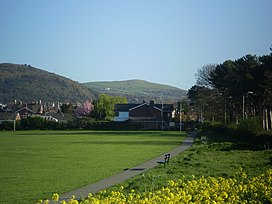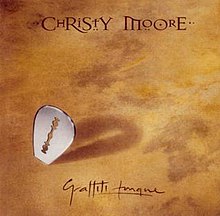코모히파리온
Cormohipparion| 코모히파리온 | |
|---|---|
 | |
| 애쉬폴 화석층 속 코르모히파리온과 텔레오케라스 | |
| 과학적 분류 | |
| 왕국: | 애니멀리아 |
| 문: | 챠다타 |
| 클래스: | 젖꼭지 |
| 주문: | 페리소닥틸라속 |
| 패밀리: | 에쿠스과 |
| 서브패밀리: | 물푸레나무과 |
| 부족: | †히파리오니 |
| 속: | †코모히파리온 스키너 & 맥패든, 1977년 |
| 모식종 | |
| ② 히파리온 발생 | |
| 아속 및 종 | |
| ② 가마히파리온
②노티오크라도하이파리온
| |
코모히파리온은 마이오세 말기부터 플리오센(NALMA [1]분류로 햄필리언에서 블랑칸)까지 북아메리카에 살았던 히파리오니족에 속하는 멸종된 말속이다.이 고대 말의 종은 [2][3]길이가 3피트(1미터)까지 자랐습니다.
분류법
코르모히파리온속은 1856년 [4]조지프 레이디가 묘사한 멸종된 히파리오닌 말 "에쿠스"를 위해 만들어졌다.그러나 곧 부분적인 물질은 히파리온에서 볼 수 있는 형태학적 변이의 범위에 속하며, 코모히파리온의 구성원들은 히파리온에 [5][6]속한다는 주장이 제기되었다.이는 궤도 전 형태학이 분류학적으로 의미가 없다는 주장과 채석장 구획에 대한 상세한 연구가 나중에 [7]거짓으로 판명된 주장에 근거했다.이 속은 원래 폐쇄된 안와에 의해 확인되었지만, 나중에 코모히파리온 표본의 볼 치아, 특히 아래 볼 치아에 대한 조사 결과, 실제로 유효하고 히파리온과 [8]구별되는 것으로 밝혀졌다.따라서 1984년에 [9]많은 말의 속들에 대한 재평가가 이루어졌고, 제안된 동의어는 이후의 [10]문헌에 의해 인정되지 않았다.C. ingenuum은 플로리다에서 묘사된 최초의 선사시대 말일 [11]뿐만 아니라 플로리다에서 발견된 가장 흔한 멸종 종의 세 발가락 말들 중 하나라는 점에서 구별된다.Cormohipparion emsliei는 화석 [12]기록으로 알려진 마지막 하마목마라는 특징을 가지고 있다.
이 속은 히포테륨의 [13]조상을 나타내는 것으로 여겨진다.그것의 화석은 [14]멕시코만큼 남쪽에서 발견되었다.화석은 북미의 그레이트플레인스와 리오그란데 지역에서 발견되었는데, 이는 그들이 목축 [15][16][17][18]동물이었다는 것을 보여준다.
레퍼런스
- ^ MacFadden, Bruce J.; Skinner, Morris F. (1982). "Hipparion Horses and Modern Phylogenetic Interpretation: Comments on Forsten's View of Cormohipparion". Journal of Paleontology. 56 (6): 1336–1342. ISSN 0022-3360. JSTOR 1304670.
- ^ "Region 4: The Great Plains". geology.teacherfriendlyguide.org. Retrieved 2021-06-23.
- ^ Oklahoma Geology (PDF). Vol. 61, no. 3. Fall 2001 http://ogs.ou.edu/docs/geologynotes/GN-V61N3.pdf.
{{cite magazine}}:누락 또는 비어 있음title=(도움말) - ^ Skinner, M. F.; MacFadden, B. J. (1977). "Cormohipparion n. gen. (Mammalia, Equidae) from the North American Miocene (Barstovian-Clarendonian)". Journal of Paleontology. Paleontological Society. 51 (5): 912–926. JSTOR 1303763.
- ^ Forsten, A. (1982). "The Status of the Genus Cormohipparion Skinner and MacFadden (Mammalia, Equidae)". Journal of Paleontology. Paleontological Society. 56 (6): 1332–1335. JSTOR 1304669.
- ^ MacFadden, Bruce J. (1985). "Patterns of Phylogeny and Rates of Evolution in Fossil Horses: Hipparions from the Miocene and Pliocene of North America". Paleobiology. 11 (3): 245–257. doi:10.1017/S009483730001157X. ISSN 0094-8373. JSTOR 2400665.
- ^ MacFadden, B. J.; Skinner, M. F. (1982). "Hipparion Horses and Modern Phylogenetic Interpretation_ Comments on Forsten's View of Cormohipparion". Journal of Paleontology. Paleontological Society. 56 (6): 1336–1342. JSTOR 1304670.
- ^ Forsten, Ann (1982). "The Status of the Genus Cormohipparion Skinner and MacFadden (Mammalia, Equidae)". Journal of Paleontology. 56 (6): 1332–1335. ISSN 0022-3360. JSTOR 1304669.
- ^ MacFadden, BJ (1984). "Systematics and phylogeny of Hipparion, Neohipparion, Nannippus, and Cormohipparion (Mammalia, Equidae) from the Miocene and Pliocene of the new world". American Museum of Natural History.
- ^ Hulbert Jr, R. C. (1988). "A New Cormohipparion (Mammalia, Equidae) from the Pliocene (Latest Hemphillian and Blancan) of Florida". Journal of Vertebrate Paleontology. The Society of Vertebrate Paleontology. 7 (4): 451–468. doi:10.1080/02724634.1988.10011675. JSTOR 4523166.
- ^ "Cormohipparion ingenuum". Florida Museum. 2017-03-30. Retrieved 2021-06-16.
- ^ "Neohipparion". Florida Museum. 2018-02-16. Retrieved 2021-06-26.
- ^ Woodburne, M. O. (2005). "A New Occurrence of Cormohipparion, with Implications for the Old World Hippotherium Datum". Journal of Vertebrate Paleontology. 25: 256–257. doi:10.1671/0272-4634(2005)025[0256:ANOOCW]2.0.CO;2. ISSN 0272-4634. S2CID 86241044.
- ^ Bravo-Cuevas, V. M.; Ferrusquía-Villafranca, I. (2008). "Cormohipparion (Mammalia, Perissodactyla, Equidae) from the Middle Miocene of Oaxaca, Southeastern Mexico". Journal of Vertebrate Paleontology. 28: 243–250. doi:10.1671/0272-4634(2008)28[243:CMPEFT]2.0.CO;2. ISSN 0272-4634. S2CID 131613568.
- ^ Skinner, Morris F.; MacFadden, Bruce J. (1977). "Cormohipparion n. gen. (Mammalia, Equidae) from the North American Miocene (Barstovian-Clarendonian)". Journal of Paleontology. 51 (5): 912–926. ISSN 0022-3360. JSTOR 1303763.
- ^ Bravo-Cuevas, Victor Manuel; Ferrusquía-Villafranca, Ismael (2008). "Cormohipparion (Mammalia, Perissodactyla, Equidae) from the Middle Miocene of Oaxaca, Southeastern Mexico". Journal of Vertebrate Paleontology. 28 (1): 243–250. doi:10.1671/0272-4634(2008)28[243:CMPEFT]2.0.CO;2. ISSN 0272-4634. JSTOR 30126348. S2CID 131613568.
- ^ Hulbert, Richard C. (1988). "A New Cormohipparion (Mammalia, Equidae) from the Pliocene (Latest Hemphillian and Blancan) of Florida". Journal of Vertebrate Paleontology. 7 (4): 451–468. doi:10.1080/02724634.1988.10011675. ISSN 0272-4634. JSTOR 4523166.
- ^ MacFadden, Bruce J.; Skinner, Morris F. (1981). "Earliest Holarctic Hipparion, Cormohipparion goorisi n. sp. (Mammalia, Equidae), from the Barstovian (Medial Miocene) Texas Gulf Coastal Plain". Journal of Paleontology. 55 (3): 619–627. ISSN 0022-3360. JSTOR 1304276.



